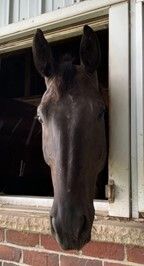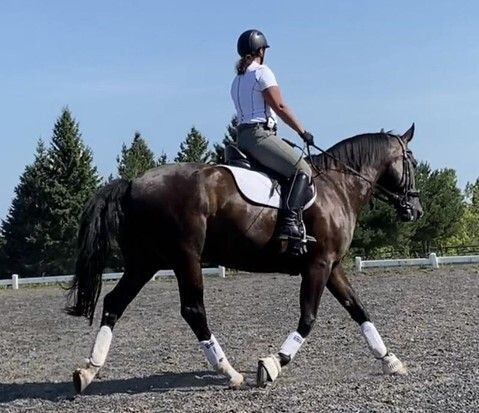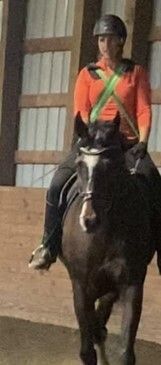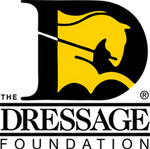Gifted Memorial Fund for Adult Amateurs Recipient: Jenna Staffaroni (Region 2)

I’m always interested to hear how other riders got into the sport of dressage. Growing up, I always wanted a horse of my own. Unfortunately, this wasn’t possible at the time as I grew up in a subdivision with a family who knew very little about horses. Luckily, I still had the opportunity to learn and ride through my friends at school. We raced in the corn fields, jumped anything we could configure in the pasture, and took rides down the road while hoping to avoid the dreaded UPS man that we always seemed to encounter at the most inopportune times. Despite laughs and falls, I always promised myself I would own my horse one day.
Fast forward to the summer of 2017. After six tedious years away at college, I graduated with a Master’s degree in Clinical Perfusion, accepted a position in a new city, and finally had some free time and an income. I was ready to pursue my interests and I started my horse search! I surfed the sale pages for months and nothing caught my eye until one day I came across an 18-year-old Percheron gelding, Bill. He was retiring from his current job as a sleigh horse. I had very limited knowledge of what to look for when purchasing a horse but off I went. As soon as I saw him, I knew he was the horse for me. There was something about his kind eyes and gentle disposition that locked me in. I was sold.
Boy did I get lucky with Bill! It could have been his experience, it could have been his breed, but he was the best first horse a girl could ask for. Riding and time at the barn quickly became one of my biggest priorities. I looked for every opportunity to ride and explore new areas with him. It was by chance that I stumbled upon our first dressage clinic. Now as you can imagine, we got a few odd stares…me a clueless trail rider who just learned what a posting diagonal was, and Bill a stiff and arthritic heavy horse. Fortunately for us, the other dressage riders I came across were so welcoming and encouraging. I remember watching other rides and being motivated as they worked on their extended trot and canter half-passes. I had never seen anything that looked so effortless and graceful! I couldn’t wait to see how far we could go, but sadly our time was cut too short. After just three years with Bill, he passed away unexpectedly. His absence left such a void in my heart; I didn’t think I could ever ride again.
As I mourned Bill, I continued to spend time at the barn where we had created so many friendships over the years. One day a boarder excitedly asked if I had seen the new horse that had just come in. Excitedly, we headed down to the barn to check it out. Standing there in all his glory was Fibonacci, a five-year-old Oldenburg gelding. Tall and jet black with an athletic build, this guy was a stunner. I could tell from visiting him in his stall he had an inquisitive nature and social personality, but I learned he lacked respect for a handler and struggled with boundaries. He was going to take some work from his handler, but their time put in would surely pay off because his natural ability and floaty gaits provided him with unlimited potential. Knowing I was missing my horse and had some time for a project, the owner asked if I would like to start working with him. I excitedly agreed. I had the opportunity to lease Leggs for eight months before deciding to buy him in June of 2021.
As you can imagine, going from a 21-year-old Percheron to a five-year-old warmblood has provided me with a STEEP learning curve over the last two years. With daily turnout to burn some of that young energy and help from a confident trainer, Leggs and I have formed a partnership! However, with my inexperience and his challenging personality, it is easy for me to lose confidence in my aids, and we often lack the structure of a professional lesson during our rides. I find we progress so much faster by having a set of eyes on the ground because my riding often feels better than it looks. This is often difficult to do with my daily work requirements and a trainer who lives an hour and a half away, but we always tried to prioritize this time every four to six weeks. When I learned about TDF’s Gifted Memorial Fund grant, I felt like it was created specifically for riders in my situation. I knew the grant would alleviate the time and distance strain of professional training and allow me to kickstart our First Level training, so I applied.
I was thrilled when I heard Leggs and I received a grant! We had so many goals heading into our training. As easy as it could be to focus solely on riding, I wanted to prioritize bonding with Leggs too. I always had to board my horses, so I never had the opportunity to learn their routines and enjoy much downtime with them. Besides strengthening our partnership, I wanted to develop the skills needed to ride a successful First Level test. For this to happen, I needed to learn how to encourage trust and relaxation for my horse in an unfamiliar show setting. Once this was achieved, we could improve our accuracy of patterns, start working to achieve balance in smaller circles and introduce lengthening strides in the trot and canter.
Initially, I planned to spend a week in April taking lessons from my trainer of the last several years, Nicole Perret (Essence of Dressage). However, due to a horse injury, my training dates were postponed until August. I knew this new timeline wasn’t ideal because the month prior I was getting married, and I wouldn’t have much time to ride. With that in mind, I decided to bring Leggs to the Wisconsin Equestrian Center (WEC) a few weeks early so Nicole could start working with him and keep him in shape while I was away on my honeymoon. I knew Leggs would be happy with this decision because he loves Nicole. Students often joke that she is ‘The Horse Whisperer’ because the horses in training adore her and are so happy to come into lessons!

I eagerly awaited my week at WEC. At last, the time had come! The plan was to take two lessons a day--one with Leggs and one with Nicole's school horse, Parker. This was done so I could build a better sense of confidence for my aids and feeling of the movement on a more experienced horse, and then take that knowledge into my lesson with Leggs. The ability to repeat Nicole’s directions twice resulted in lessons with great improvement! It was easier to ingrain the knowledge and develop a sense of muscle memory so we could progress each day by adding something new. Below is a summary of these lessons and any ‘Ah-Ha!’ moments (which I describe as the moment all the pieces seem to come together and you’re left asking yourself why on earth it took so long to understand the concept!).
Day 1: Learning to Control the Shoulders
Lesson on Leggs - Exercises included walk/trot transitions while keeping him on the outside rein. To do this, I had to practice controlling his shoulders. Leggs likes to throw his right shoulder and bend left so to correct this I learned to use my right leg aid in front of the girth to move the shoulders over. If he didn’t respond to my leg, I used the whip lightly on the shoulder he was falling out on. Keeping him more consistently on the outside rein allowed me to use it for steering. I would often resort to leading a turn with the inside rein which would result in him overbending in the neck and often losing tempo. I learned that the inside rein should be used primarily for flexion rather than turning the horse. Using the outside rein and outside leg to steer allows the horse to remain straighter and more connected to the bit. We finished up this lesson and ensured we had control of the shoulders by practicing turning on the haunches. We rarely worked on this movement but learned it was a great exercise to make sure Leggs was supple to my outside rein. To prepare for the movement, I would half halt to slightly slow him and activate his walk, and my upper body would turn in the direction of the movement along with my outside leg aid to bring his shoulders around to the new line of travel. It was amazing how fast he picked up this exercise after repeating it a few times!

We appear straighter and better connected with more consistent use of my outside rein.
Lesson on Parker - We started this lesson with turning on the haunches which was a nice reminder to the use of the outside rein and outside leg to initiate turns. My ‘Ah-Ha’ Moment: When the shoulders fall out in one direction, my reflex is to use my inside rein to pull the horse back onto the line of intended travel. Instead, I should be using my outside rein and outside leg to move the shoulders in the direction I want to go which will prevent the horse from over bending at the neck to the inside and escaping out the outside shoulder. In this lesson, Nicole also noticed I’m stronger on my right side and I lead with that hip when posting, which really throws my body out of alignment when trying to do shoulder-in to the left! I was told to think ‘hips to hands’ on each post to keep them even, which seems to help me by having that visual. We ended this lesson with shoulder-in. I learned when my horse starts drifting off the rail, I need to check the outside rein which is responsible for keeping them on the track. To complete shoulder-in the inside rein is used for slight flexion while the inside leg pushes their body down the rail.
Day 2: My Hips Turn in the Wrong Direction!
Lesson on Leggs - No wonder why I feel like I have no steering, I tend to lead my turns with my inside hip rather than turning them in the direction of travel! I practiced this newfound knowledge with lots of three-loop serpentines. Leggs was bending beautifully and responding so much better to my seat, I barely had to use my reins! Obviously, muscle memory is difficult to change, and this is something I will need to remind myself of constantly when riding. I learned that a good test to see if my hips are in the correct position is to give away my inside rein while on a 20m circle. If the horse comes off the circle or tries to circle in the opposite direction, my hips are likely in the wrong position! My right hip loves to float forward, especially when I want to put my right leg on. Even though realizing my hip issue felt like victory enough, we finished the lesson with some canter work.
I learned I tend to decompress my core when asking for the canter departure and tend to bear down which causes Leggs to lift his head and come off the bit. To help get him back, I learned to time my half-halts on beat ‘2’ of the canter rather than sporadically ‘talking’ with the bit. I felt that gave us such a better connection and I didn’t feel like I was constantly bumping on his mouth!
Lesson on Parker - Staying conscious of my hips, I tried half-pass for the first time. This was exciting because the beauty of this movement is what had me dreaming of dressage since my first clinic! We broke down the movement and started with shoulder-in (weight in outside seat bone) down the rail. Once that felt good, I then asked Parker to take the shoulder-in to the quarter line using my outside leg to yield (half-pass!). I learned it’s incredibly hard for me to keep my right hip back when using the right leg aid. Further notes from this lesson included: Make sure you’re riding every corner (use it to set up for the next test movement!). When heading into a corner I should run through the quick checklist ‘Bend, Flex, Hips in direction of travel’ to make sure I have all my pieces together.

Keeping my hips in the correct direction and looking in the direction I want to go has helped us maintain better balance on a 20m circle.
Day 3: Trot Lengthening
Lesson on Leggs (only) - After a long evening of thunderstorms, we were able to experience puddles in the outdoor ring for our lesson, oh what fun! You would think a horse with regular turnout would be used to such conditions, but Leggs is very much a horse that doesn’t like to get his feet dirty. He doesn’t even like to leave the shelter if it is raining! This was a good warm-up because he was thinking he could make the decision to leave the ring at ‘A’ rather than continue through the big puddle. With my reflex to steer with the inside rein, this was great practice to make sure I was using my outside aids to keep him on the line of intended travel. Nicole explained the importance of looking where I wanted to go during these situations. When passing ‘F’ tracking right, I should already be looking at and riding through to ‘K’, not focusing on ‘A’ where he wanted to step out. It was important I turn with my whole body and not just my head. This allowed me to be stronger in my aids and after a few corrections, we rode through the puddles with ease!
Now for something new, trot lengthening! Leggs can be behind the leg at times and often when I ask for more go, he’ll pop his head up and suck back, not wanting to move forward. Obviously, this posed a significant challenge for our trot-lengthening strides. I learned the correct sequence of aids to ask for trot lengthening across the diagonal is to first set up for the movement in the corner (making sure it's not too deep of a corner). Then, when leaving the corner, push the reins to the bit, post BIG, and add some leg (a gentle tap with the whip if needed). When Leggs tried to break into a canter instead of lengthening, I corrected him with a half halt to bring him back to trot and immediately asked him again. As you can imagine, our first few tries were not pretty--remember we had never tried this before! At the very end of the lesson, we had one beautiful lengthening across the diagonal, and I couldn’t help but smile because I could feel the difference immediately. I promptly gave him lots of praise and one of his favorite peppermint treats to let him know he got it right.
Day 4: - Finding Suppleness in the Canter
Lesson on Leggs - Today we decided to address our canter work. Though we have gotten better in the last year, we still struggle with the immediacy of the departure and staying supple through the transition. It was obvious from this lesson that Leggs will often ignore my left leg canter aid, so I need to stay consistent and back up that ask with a tap of my whip if needed. Several areas of improvement were identified for me during this lesson, one being that my wrists tend to get stiff as I ride. When I feel Leggs starting to get heavy in my hand or brace against me, it’s my reminder to ‘shake the wrists out,' which will allow my hands to stay soft and for me to become more controlled with the whip. Another realization in this lesson was the tendency for my left leg to float forward at the knee in the canter which was signaling him to break into trot. I must keep my canter aids in position until I am ready for a transition. Lastly, when I am in the canter my reins get long when asking him to be supple because I ‘give’ and ‘relax’ my hand, but I tend to give a little too much!
Lesson on Parker - We continued with our canter exercises but added counter canter! I had not worked on this previously. I quickly learned how important it is for me to control my hips to pick up the desired lead. We then had a cool down with some should-in and haunches-in. I was reminded of my unbalanced nature when I struggled with shoulder-in to the left and haunches-in to the right. This imbalance seems to get worse as my body fatigues. I think it’s time for a Pilates membership!
Day 5: The Worst and Best Rides of the Week!
Lesson on Leggs - Is it just me or is horsemanship an emotional rollercoaster? After four days of great progress and ‘Ah-Ha!’ moments, I was prepared for this to be our last lesson. However, Leggs decided he was done the day prior. The guy just didn’t want to go! When I asked for a trot, he would immediately pop his head up, suck back, and if I came with a small touch of the whip or more leg, he would give evasive half steps and act like he wanted to rear. We ruled out any sources of discomfort. So, what can you do in this situation when your horse wants you off their back?
1). Safely get control of the neck using one rein at a time (NOT BOTH!) You can turn, serpentine, circle, whatever you can to get the neck from bracing against you!
2). Use one squeeze of the calf to ask for forward while being careful to not use the heel (at least with Leggs, he does not like the heel!).
3). If he does not respond to the leg, use small touches of the whip.
4). Stay consistent, you may need to go through this cycle a few times before they start moving forward!
More often than not, if a horse gets crabby with you there is a reason. In this case, I was the problem! I was using way too many aids and unintentionally nagging with my calves, voice, and ‘baby taps’ of the whip to try and coax him forward (no wonder he was upset with me, how annoying!). After a brief test of patience and willpower, I learned that the quieter I was, the more he listened!

Lesson on Parker – In this lesson I was able to try the P2 Smart Rider Performance Bands (no affiliation). These resistance bands, which cross over your body when riding, are designed to give you the feel of the right muscle groups that should be engaging to give you a secure and balanced seat. I felt plugged into the saddle immediately and more secure! Using the bands, my legs were in a much better position. This allowed me to see how much my thighs and knees tend to rotate outward. After 10 minutes in the bands, I had the muscle memory to continue my ride in the correct position with my inner thighs flushed with the saddle and weight in the balls on my feet. This put my leg in the perfect position to ask for more ‘go’ with the calf rather than drawing up my leg and using my heel. With this position, I felt strong and steady in the saddle and could immediately feel that my lower leg was no longer gripping and bumping in the trot! We carried this new position into some canter work to end the lesson, again working on suppleness. Nicole suggested I try to maintain the feeling of 50% weight in my left rein and 50% weight in my right rein when riding the horse and that really helped me visualize the connection I have with the bit.
Day 6: The Miracle Lesson
Lesson on Leggs (only) - After a discouraging start in our previous lesson, I wanted to make sure Leggs and I worked through his resistance to move forward. Because it felt so great using the P2 bands on Parker, I wanted to try them on Leggs. I think he was just as happy with the decision as I was! With my lower leg learning to stay off the horse and not nag, Leggs was responding better to the slightest squeeze of the calf with more forward energy. He was creating consistent impulsion, driving from his back legs, and it felt so empowering. The difference in his ‘go button’ was miraculous! Maybe it was my poor position that caused him to be behind the leg previously?
As my week at WEC concluded, I felt confident that we were given the right tools to continue our progress at home. I could share a few points of advice with other riders, it would be:
1. Find a trainer who can be on the ground giving you feedback as you ride. They can see things that we don’t feel, and you will progress so much faster!
2. Keep diligent notes after each lesson to look back on. It helps to have video clips too that you can review in between lessons.
3. Be teachable! Take the suggestions from your trainer and keep an open mind. A given approach may seem uncomfortable or weird now (i.e., leg position) but it could be the fix you need that will make all the difference in your riding.
4. Be ready to adapt and ride the horse you have that day. You may go into a lesson expecting to school counter canter but end up working on not spooking in the scary corner of the arena. Don’t get discouraged! We all have those days.
5. Feed changes matter! After coming home Leggs was so spooky in the arena. My trainer suggested he was getting too much sugar with 24/7 turnout, so I limited him to four hours a day and it has made all the difference!
6. Don’t be scared to ask for help. It doesn’t matter how long you have been riding, we all have different experiences and can learn from each other. Share your knowledge too!
There is no better feeling than dismounting after a great ride and if you’re anything like me, this joy carries throughout the rest of the day! After a full week of successful lessons, my motivation to continue this progress is overwhelming. I could have never achieved this feeling without the support and assistance of the Gifted Memorial Fund through The Dressage Foundation. This organization has given me the opportunity to strengthen my personal relationship with Leggs and start our dressage career correctly with an enhanced understanding of the fundamentals. My sincerest gratitude goes out to all the donors and volunteers at TDF who help make these opportunities for adult amateurs possible. I have learned more through this experience than I had ever thought possible, and I look forward to sharing my findings with other aspiring riders.
